
HNLMS Abraham Crijnssen is a Jan van Amstel-class minesweeper of the Royal Netherlands Navy (RNN).

The Royal Netherlands Navy is the naval force of the Kingdom of the Netherlands.
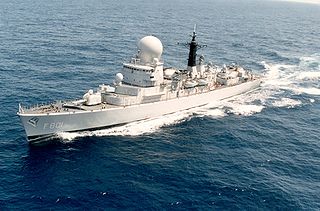
The Tromp class were two frigates built for the Royal Netherlands Navy during the 1970s to replace the De Zeven Provinciën-class cruisers as squadron flagships.
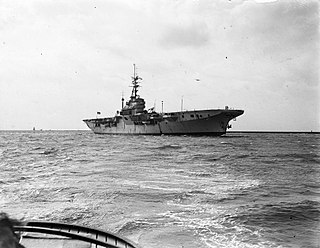
HNLMS Karel Doorman (R81) was a Colossus-class aircraft carrier of the Royal Netherlands Navy. Formerly the British ship HMS Venerable, she was sold to the Netherlands in 1948 as a light attack carrier. In 1960, she was involved in the decolonization conflict in Western New Guinea with Indonesia. In the mid 1960s the role was changed to anti-submarine warfare carrier and only ASW aircraft and helicopters were carried. An engine room fire took her out of service in 1968. She was sold to Argentina in 1969 and renamed ARA Veinticinco de Mayo.

The Karel Doorman-class frigates are a series of eight multi-purpose vessels built for the Royal Netherlands Navy. Its namesake is Karel Doorman, a Dutch naval officer whose ship was struck by a Japanese torpedo in the battle of the Java Sea in 1942, and who, as a result of which, went down with his ship.

The Holland-class destroyers were built for the Royal Netherlands Navy in the 1950s. They were the first major warships designed and built by the Dutch after World War II. In contrast to previous Dutch Navy practice the ships were named after provinces rather than admirals.
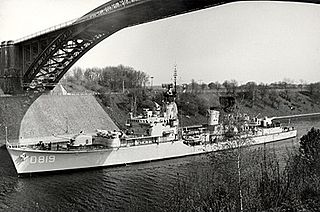
The Friesland-class destroyers were built for the Royal Netherlands Navy in the 1950s. They were a larger modified version of the Holland class with more powerful machinery. Eight ships were built. They were replaced by the Kortenaer-class frigates in the early 1980s and seven ships were sold to the Peruvian Navy where they served until 1991. The main armament was supplied by Bofors.

The Dolfijn-class submarines of the Royal Netherlands Navy are a class of four submarines; Dolfijn, Zeehond, Potvis and Tonijn. They were built in the late 1950s and the early 1960s. They were the first indigenous submarines built in the Netherlands and for the Royal Netherlands Navy after World War II. In the Netherlands they are also known as "three cylinder" submarines.
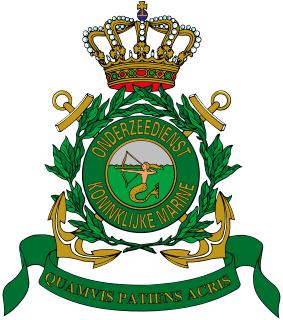
The Royal Netherlands Navy Submarine Service is a department within the Royal Netherlands Navy that is responsible for the deployment of Dutch submarines. It was established out of the Netherlands Torpedo Service on 21 December 1906, and merged with the Netherlands Mine Service on 15 July 2005.

O 19, laid down as K XIX, was an O 19-class submarine of the Royal Netherlands Navy that saw service during World War II. O 19, along with her sister ship O 20 were the first submarines in the world to be equipped with a submarine snorkel that allowed the submarine to run its diesel engines while submerged.

HNLMS Van Kinsbergen was a unique sloop of the Royal Netherlands Navy build by Rotterdamsche Droogdok Maatschappij. She served in the Dutch West Indies in 1940. Later, she served as escort vessel and survived World War II. She was decommissioned on 29 May 1959 and was sold for scrap on 19 May 1974.

The O 19 class was a class of two submarines, built for the Royal Netherlands Navy by Fijenoord, Rotterdam. The ships were designed as submarine minelayer for operations in both European and colonies waters. The class comprised O 19 and O 20 and were the first submarines in the world to be equipped with a submarine snorkel that allowed the submarine to run its diesel engines while submerged. The submarines diving depth was 100 m (330 ft). These units were very similar to earlier Polish Orzeł class, with a reduced torpedo battery and 10 vertical mine tubes fitted on each beam.

The Van Amstel class was a class of six frigates that were built during the Second World War in the United States and served as Cannon-class destroyer escort during that war. After the war the destroyer escorts were loaned to the Dutch navy as part of the MDAP and from 1950 to 1967 served as the Van Amstel-class frigates.

HNLMS Poolster was a replenishment ship serving with the Royal Netherlands Navy. Poolster entered service on 29 June 1964. In 1994 she was decommissioned and sold to the Pakistan Navy where the ship was renamed Moawin. A later replenishment ship Zuiderkruis was based on Poolster. In the Dutch navy she was replaced by the replenishment ship Amsterdam. She was the first ship in the Dutch navy with inbuilt protection against radioactive fallout.
HNLMS Zeeland (D809) was a destroyer of the Holland class. The ship was in service with the Royal Netherlands Navy from 1955 to 1979. The destroyer was named after the Dutch province of Zeeland and was the twenty-first ship with this name. In 1978 the ship was taken out of service and later broken up and scrapped. The ship's radio call sign was "PAAU".

HNLMS Van Galen (F834) is a ship of the Karel Doorman class of multi-purpose frigates of the Royal Netherlands Navy. Built by the shipyard Koninklijke Schelde Groep in Vlissingen. The ship is named after captain and convoy commander Johan van Galen and served from 1994 to 2008 with the Dutch navy. The radio call sign of the frigate was "PAMG".

HNLMS Tromp (F801) was a frigate of the Tromp class. The ship was in service with the Royal Netherlands Navy from 1975 to 1999. The frigate was named after Dutch naval hero Tromp. The ship's radio call sign was "PADE".
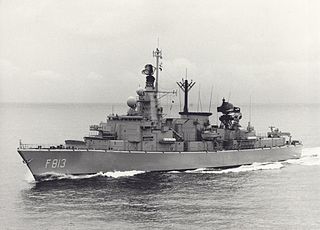
HNLMS Witte de With (F813) was a frigate of the Jacob van Heemskerck class. The ship was in service with the Royal Netherlands Navy from 1986 to 2006. The frigate was named after Dutch naval hero Witte Corneliszoon de With. The ship's radio call sign was "PAVP".

HNLMS Jacob van Heemskerck (F812) was a frigate of the Jacob van Heemskerck class. The ship was in service with the Royal Netherlands Navy from 1986 to 2004. The frigate was named after Dutch naval hero Jacob van Heemskerck. The ship's radio call sign was "PAVO".

HNLMS Philips van Almonde (F823) was a frigate of the Kortenaer class. The ship was in service with the Royal Netherlands Navy from 1981 to 2002. The frigate was named after Dutch naval hero Philips van Almonde. The ship's radio call sign was "PADF".

















